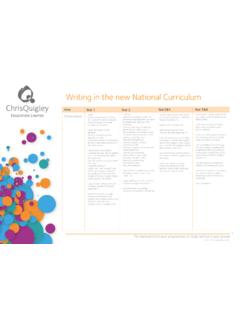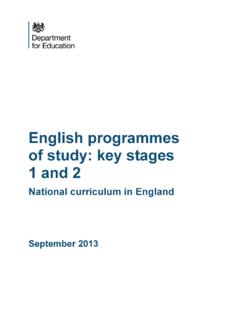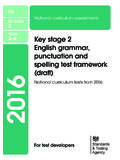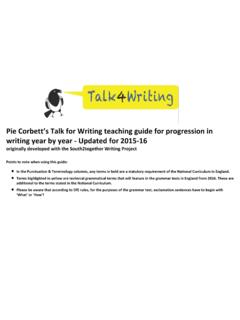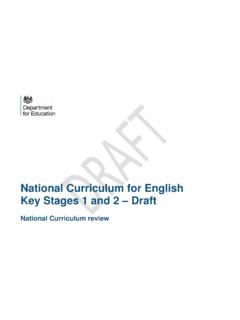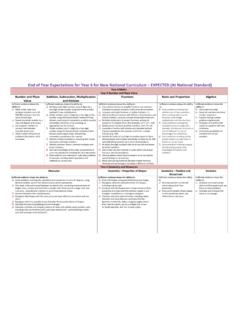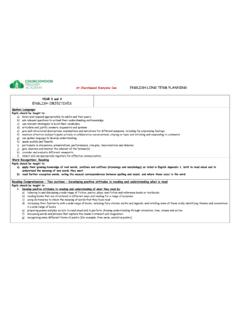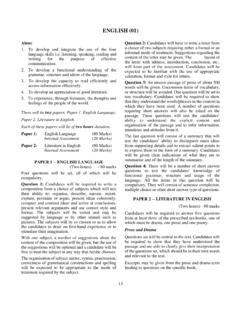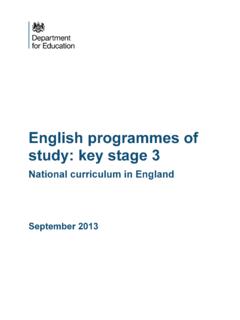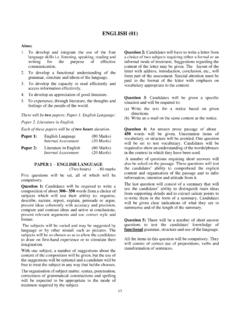Transcription of Writing in the new National Curriculum - …
1 Writing in the new National Curriculum Area year 1 year 2 Year3&4 year 5&6. spell: spell by: use further prefixes and suffixes use further prefixes and suffixes Transcription words containing each of the segmenting spoken words into and understand how to add them and understand the guidance for 40+ phonemes already taught phonemes and representing these (English Appendix 1) adding them common exception words by graphemes, spelling many the days of the week correctly spell further homophones spell some words with silent'. learning new ways of spelling letters [for example, knight, name the letters of the phonemes for which one or spell words that are often psalm, solemn]. alphabet: more spellings are already known, misspelt (English Appendix 1).
2 Naming the letters of the and learn some words with each continue to distinguish between alphabet in order spelling, including a few place the possessive apostrophe homophones and other words using letter names to distinguish common homophones accurately in words with regular which are often confused between alternative spellings of learning to spell common plurals [for example, girls', boys']. the same sound exception words and in words with irregular plurals use knowledge of morphology learning to spell more words with [for example, children's] and etymology in spelling and add prefixes and suffixes: contracted forms understand that the spelling of using the spelling rule for adding learning the possessive use the first two or three letters some words needs to be learnt s or es as the plural marker apostrophe (singular) [for of a word to check its spelling in a specifically, as listed in English for nouns and example, the girl's book] dictionary Appendix 1.
3 The third person singular marker distinguishing between for verbs homophones and write from memory simple use dictionaries to check the using the prefix un near-homophones sentences, dictated by the spelling and meaning of words using ing, ed, er and est teacher, that include words and where no change is needed in add suffixes to spell longer words, punctuation taught so far. use the first three or four letters the spelling of root words [for including ment, ness, ful, of a word to check spelling, example, helping, helped, helper, less, ly meaning or both of these in a eating, quicker, quickest] dictionary apply spelling rules and guidance, apply simple spelling rules and as listed in English Appendix 1 use a thesaurus.
4 Guidance, as listed in English Appendix 1 write from memory simple sentences dictated by the teacher write from memory simple sentences dictated by the teacher that include words using the GPCs and common exception words taught so far. 1. The National Curriculum programmes of study laid out in year groups 2013 Chris Quigley Education Ltd Writing in the new National Curriculum Area year 1 year 2 Year3&4 year 5&6. Handwriting sit correctly at a table, holding a form lower-case letters of the correct size relative to one use the diagonal and horizontal write legibly, fluently and with increasing speed by: pencil comfortably and correctly strokes that are needed to join another letters and understand which begin to form lower-case letters letters, when adjacent to one choosing which shape of a letter in the correct direction, starting start using some of the diagonal another, are best left unjoined to use when given choices and and finishing in the right place and horizontal strokes needed to deciding whether or not to join join letters and understand which increase the legibility, consistency specific letters form capital letters letters, when adjacent to one and quality of their handwriting choosing the Writing implement another, are best left unjoined [for example.]
5 By ensuring that the that is best suited for a task. form digits 0-9 downstrokes of letters are parallel write capital letters and digits of and equidistant; that lines of understand which letters belong the correct size, orientation and Writing are spaced sufficiently so to which handwriting families' relationship to one another and to that the ascenders and ( letters that are formed lower case letters descenders of letters do not in similar ways) and to practise touch]. these. use spacing between words that reflects the size of the letters. 2. The National Curriculum programmes of study laid out in year groups 2013 Chris Quigley Education Ltd Writing in the new National Curriculum Area year 1 year 2 Year3&4 year 5&6.
6 Write sentences by: develop positive attitudes plan their Writing by: plan their Writing by: Composition saying out loud what they towards and stamina for Writing discussing Writing similar to that identifying the audience for and are going to write about by: which they are planning to write purpose of the Writing , selecting the composing a sentence orally Writing narratives about personal in order to understand and learn appropriate form and using other similar before Writing it experiences and those of others from its structure, vocabulary and Writing as models for their own sequencing sentences to (real and fictional) grammar noting and developing initial ideas, form short narratives Writing about real events discussing and recording ideas drawing on reading and research where re-reading what they have Writing poetry necessary written to check that it Writing for different purposes draft and write by.
7 In Writing narratives, considering how makes sense composing and rehearsing authors have developed characters and consider what they are going to sentences orally (including settings in what pupils have read, discuss what they have write before beginning by: dialogue), progressively building listened to or seen performed written with the teacher or planning or saying out loud what a varied and rich vocabulary and other pupils they are going to write about an increasing range of sentence draft and write by: Writing down ideas and/or key structures (English Appendix 2) selecting appropriate grammar and read aloud their Writing words, including new vocabulary organising paragraphs around a vocabulary , understanding how such clearly enough to be heard encapsulating what they want to theme choices can change and enhance by their peers and the say, sentence by sentence in narratives, creating settings, meaning teacher.
8 Characters and plot in narratives, describing settings, make simple additions, revisions in non-narrative material, using characters and atmosphere and and corrections to their own simple organisational devices integrating dialogue to convey Writing by: [for example, headings and character and advance the action evaluating their Writing with the sub-headings] pr cising longer passages teacher and other pupils using a wide range of devices to build re-reading to check that their evaluate and edit by: cohesion within and across paragraphs Writing makes sense and that assessing the effectiveness of using further organisational and verbs to indicate time are used their own and others' Writing and presentational devices to structure text correctly and consistently, suggesting improvements and to guide the reader [for example, including verbs in the continuous proposing changes to grammar headings, bullet points, underlining].
9 Form and vocabulary to improve proof-reading to check for consistency, including the evaluate and edit by: errors in spelling, grammar and accurate use of pronouns in assessing the effectiveness of their punctuation [for example, ends of sentences own and others' Writing sentences punctuated correctly] proposing changes to vocabulary , proof-read for spelling and grammar and punctuation to enhance read aloud what they have written punctuation errors effects and clarify meaning with appropriate intonation to ensuring the consistent and correct use make the meaning read aloud their own Writing , of tense throughout a piece of Writing clear. to a group or the whole class, ensuring correct subject and verb using appropriate intonation and agreement when using singular and controlling the tone and volume plural, distinguishing between the so that the meaning is clear.
10 Language of speech and Writing and choosing the appropriate register proof-read for spelling and punctuation errors perform their own compositions, using appropriate intonation, volume, and movement so that meaning is clear. 3. The National Curriculum programmes of study laid out in year groups 2013 Chris Quigley Education Ltd Writing in the new National Curriculum Area year 1 year 2 Year3&4 year 5&6. develop their understanding develop their understanding of develop their understanding of develop their understanding of the vocabulary , of the concepts set out in the concepts set out in English the concepts set out in English concepts set out in English Appendix Appendix 2 by: Appendix 2 by: 2 by: grammar English Appendix 2 by.

